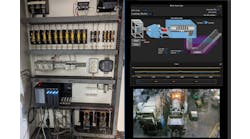Over the past three decades, industry has invested a tremendous amount of time and effort into alarm management. Indeed, industry groups such as the Abnormal Situation Management Consortium have developed a range of standards, best practices and guidelines designed to help users to implement more meaningful alarm strategies—and to excise those alarms that are spurious and distracting.
Too often, alarm management is treated as a discrete event, a one-time exercise in alarm rationalization, according to Chris Stearns, product manager for Honeywell Process Solutions’ DynAMo alarm management software. “But plants aren’t static; many things change and alarm management strategies need to adapt,” Stearns said in his presentation “Don’t Just Report on Alarms, Take Action!” this week at the Honeywell Users Group Americas 2017 conference in San Antonio.
Industry guidelines typically mention the need for alarm management to be viewed as a continuous improvement process, and with the R200 release of DynAMo Metrics & Reporting (M&R), Honeywell has significantly improved the ability of alarm management champions to understand and address alarm management issues—many from the comfort of their offices. “We’re working to bring analytics to bear,” Stearns said.
Central to the R200 release of DynAMo M&R are SMART Reports, interactive web pages that allow users to cross reference and drill down on alarm phenomena. “These reports combine all the relevant data in one place, and users can expose more tools as they’re needed,” Stearns explained.
[sidebar id =1]
Examples include a “bad actors” report (which is just what it sounds like), as well as reports that single out fleeting, chattering and frequent alarms. A new “sequence of events on steroids” report called Event Investigator allows users to correlate events across some 40 different alarm aspects. And a “repeat offenders” report allows users to differentiate continuous problems vs. alarms repeated over a short period of time that may have been related to a known process issue that has since been resolved.
Toward prescriptive alarm management
Importantly, R200 moves DynAMo M&R solidly in the direction of prescriptive analytics for alarm management. In a simple example, Stearns drilled down into the settings behind a chattering alarm to find that no on/off delay had been set for the alarm.
Further, the software displayed a model-driven matrix showing what sort of reduction in alarm frequency should be achievable using delays of various duration (62% with a five-second delay). If a change in settings is indeed desired, the software allows the engineer to push a recommended alarm configuration change to the system’s management-of-change process, then have the modified settings automatically enforced within the control system—all without leaving one’s desk.
Other DynAMo enhancements under development fit within the broader Honeywell Connected Plant vision, Stearns said. These include enterprise reporting across sites, as well as automatic recognition of more complex patterns.



